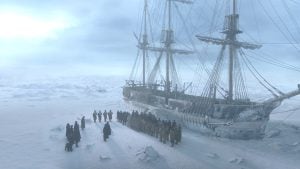Beattie theorized that lead poisoning, contracted from the solder used to seal cans of preserved food, affected the entire expedition. Its symptoms include anorexia, weakness, fatigue, anemia, paranoia, and irritability, which matched certain Inuit tales of disoriented sailors. But some researchers were skeptical that lead poisoning played a major role in what happened. Others argued that if it did, the lead probably came from the ships’ water pipes.
In April 2014, three British scientists—Keith Millar, Adrian Bowman, and William Battersby—published a statistical analysis in Significance magazine, repudiating the idea that most of Franklin’s men died of lead poisoning as too simplistic. They argued that a combination of factors killed the sailors. Further scientific analyses of bone samples support this view. And in his introduction to May We Be Spared to Meet on Earth, American scholar Russell Potter exonerates the tinned foods, stating plainly that neither lead poisoning nor botulism caused the expedition’s breakdown.
The Erebus turned up far to the south of where, supposedly, everyone abandoned it. And that brings us again to David Woodman, who in 1991 challenged the standard reconstruction with Unravelling the Franklin Mystery. Woodman created an alternative scenario, which now stands corroborated in many particulars, by sifting through Inuit accounts as gathered by explorers. After analyzing the Inuit testimony, Woodman argued that the Victory Point Record indicated only what the surviving sailors intended to do, not what they did.
Thanks to the finding of Erebus and Terror, we can see that Woodman was essentially correct. He suggested that in 1848, with Franklin dead, Captain Francis Crozier set out with the bulk of the remaining men for the mouth of Back’s Great Fish River, nine hundred miles away. Most of these men returned to the ice-locked ships. Some of them were aboard the Erebus as it sailed or was carried south by ice to Wilmot and Crampton Bay, an area known to the Inuit as Oot-joo-lik. Woodman suggested that a large group of sailors abandoned that vessel in 1851, before it reached its final resting place. Some Inuit hunters met this party of men, weak and starving, slogging south along the west coast of King William Island.
These were the men In-nook-poo-zhe-jook described to John Rae. A few sailors—probably four, according to Puhtoorak—remained aboard the ice-locked ship until early 1852. All this leaves us still with the question of root cause. Why did this expedition end in catastrophe? The Victory Point Record tells us that by 1848, nine officers and fifteen seamen had died. That represents 37 per cent of officers and 14 per cent of crew members. Historians have scratched their heads: Why such disproportionate numbers? Researchers have spent vast amounts of time and energy inquiring into the deaths of the first three sailors, whose graves remain on Beechey Island. But what if those three passings were anomalies, exceptions that tell us nothing about subsequent illness and loss of life? Perhaps the other twenty-one men—nine officers, twelve sailors—died by some other cause.
The questions keep coming. And the search continues. During the 2022 field season, Parks Canada divers retrieved 275 artifacts from the wreck of the Erebus. Along with table settings, a lieutenant’s epaulettes, and other personal effects, they brought up what archaeologist-diver Ryan Harris described as “probably the most remarkable find of the summer.” In the pantry, a colleague “came across a folio—a leather book cover, beautifully embossed—with pages inside.” It had a feather quill pen tucked inside the cover. The pages may contain an inventory of stores or food supplies, which could reveal more than one might think. How many casks of salted bear meat, for example, remained on board at such and so a date?
As we went to press with Searching for Franklin, Park Canada conservators were working on the folio. If they can decipher even mundane scribblings, that will constitute a breakthrough. It will prove that, when divers retrieve logbooks or journals from within either of the wrecks, conservators will be able to provide transcripts—and those on-site reports should answer most remaining questions. Don’t be surprised if they corroborate a new theory, advanced later in this book, about why the expedition broke down.








